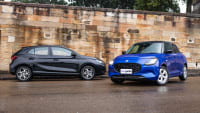Electric vehicles (EVs) are popular. And for good reason because, let’s face it, no one wants the world to become a disaster-plagued hothouse in the not-too-distant future (if we’re not already there?) and the EV, while not a magical solution in and of itself, may at least form a small part of humankind’s ever-evolving efforts to rectify the damage we have all wrought on the world during our time here.
In recent years EVs have continued to grow at pace in popularity in Australia and though recent sales figures have slowed somewhat*, these alternatives to ICE (internal combustion engine) vehicles will only become even more prevalent on our roads.
*Federal Chamber of Automotive Industries (FCAI) data published in July, 2024 signalled a dip in EV sales from 8.8 percent in June 2023 to 8.3 per cent in June this year.
So, we’ll see more EVs involved in accidents, minor and major, and we’ll see more reports of EV fires and so EV fire statistics will change.
But this doesn’t mean EVs are any more likely to catch fire or they’re any more dangerous than ICE vehicles. No, it’s simply a matter of maths: the more EVs there are on the road, the more often they’ll show up in incidents and accidents because there are more of them here.
Do electric cars catch on fire? Of course they do – well, their batteries do (more about that very soon) – and there have been increasing reports in recent years of these incidents but, again, that’s simply because there are now more EVs on the road, not because they’re more dangerous than any other vehicle.
So, what causes electric cars to catch fire? There are myriad causes, but about 40 percent of the time the EV’s battery is involved. EVs are generally powered by a lithium-ion (Li) battery also known as the EV traction battery which is “rechargeable energy storage that supplies power to the electric motor very quickly”, states Aussie company EV FireSafe, the go-to global EV fire researcher.
From verified incidents, the leading causes of EV battery fires are road traffic collision or impact with road debris, a battery fault during manufacture, submersion in a body of water, or external fire spreading to the EV and any of these circumstances have resulted in battery cell abuse, leading to thermal runaway and ignition or explosion, EV FireSafe states.
Do hybrid cars have lithium batteries? Some hybrid vehicles use a Li battery, some use a nickel-metal hydride (NiMH) battery.
Why do lithium batteries catch fire? Why do EV batteries catch fire? EV FireSafe says Li batteries “contain a large amount of energy in a very small space. Under normal operation, they rapidly convert chemical energy to electrical energy.”
But when things go awry, thermal runaway occurs, which is when “a battery cell short-circuits and starts to heat up uncontrollably”, according to EV Fire Safe. Thermal runaway is the root cause of lithium battery fires.
How often does this happen? Exactly how many electric cars catch fire every year?

This is difficult data to come by for several reasons, including the fact that not all EV fires are reported – just as not all internal combustion engine (ICE) vehicle fires are reported – or an EV destroyed by fire may have simply been parked in the garage of a house that caught fire for reasons wholly unrelated to the EV.
Or the EV’s battery has been damaged or removed from the vehicle and so the EV’s battery system is not the original source of the fire.
The same goes for figuring out how many EV fires in Australia because the cause may be difficult to ascertain. But, alas, my elite team of researchers and I will still have a crack at it and we’re referencing EV FireSafe’s ongoing work as our source material.
EV FireSafe collates real-world incident data with funding from the Australian Department of Defence and here are some insights from its June 2024 report, the company’s most up-to-date data at time of writing.
How many electric cars have caught fire? There have been 511 incidents of thermal runaway in electric passenger vehicles (BEV and PHEV) around the world since 2010.
To put that figure into perspective, it’s handy to note there are approximately 40 million EVs on the road, according to the International Energy Agency EV Outlook Update 2024.
To December 2023, there were six reported and verified electric car fires in Australia since 2010, according to EV FireSafe.
Those fires, caused by battery abuse, were the result of arson (one incident), external fire (structure burnt down around the EV, three incidents), collision (one incident) and road debris (one incident).
None of the EVs were on charge at the time, and none of the fires were spontaneous or unexplained.
So, which type of vehicle is more likely to catch fire – an internal combustion engine (ICE) passenger vehicle or an EV?

Well, it’s complicated but EV FireSafe research indicates that, based on global EV battery fires from 2010-2020, there’s a 0.0012 per cent chance of a passenger electric vehicle battery catching fire.
“While it's difficult to find a similar stat for internal combustion engine (ICE) passenger vehicles globally, a range of country-based reports we found suggest there is a 0.1% chance of an ICE vehicle catching fire,” the company states.
So, going by those figures, an ICE vehicle is just over 83 times more likely to catch fire than an EV. (0.0012 x 83.4 = 0.10008)
But EV fires remain front of mind simply because in today's 10-second news cycle everything becomes news and the subject of EVs always stir up plenty of emotion in those for and against, for better or worse.
Some noteworthy recent EV fires have included an incident on Monday, September 11, 2023, in which five cars were destroyed after a lithium-ion battery detached from one of the vehicles exploded at Sydney Airport. That same day, in the NSW Southern Highlands, an EV caught fire after it hit debris on a road at Penrose.
How many Teslas have caught fire is the subject of much scrutiny and reliable facts about a Tesla battery fire are difficult to nail down.
However, Tesla officially states: “Our global data indicates that, between 2012 and 2022, approximately one Tesla vehicle fire event occurred for every 130 million vehicle miles travelled.
By comparison, data from the NFPA [the National Fire Protection Association which reports on vehicle fire events] and U.S. Department of Transportation indicate one vehicle fire occurs in the United States for every 18 million miles traveled.”
No matter how unlikely a fire event is, though, it’s best to be prepared – and for that we need tips from Fire and Rescue NSW (FRNSW), which states: “Electric vehicles (EVs) are becoming more prevalent as consumers select greener transport options. EVs commonly contain lithium-ion batteries and come with associated risks and hazards (including fire and explosion, radiation, heat, chemical and electrical).”

How can you decrease the risk of the electric vehicle battery in your EV catching on fire? FRNSW is very clear on this subject.
“Make sure that your EV is identifiable by emergency services. There should be a blue “EV” sticker/badge on the number plate to indicate that it is an electric or hybrid vehicle. These stickers are there specifically to warn emergency responders of the presence of a high voltage battery. Information on the requirements is available from the NSW Government website.
“FRNSW recommends that a smoke alarm or a heat alarm is installed in Class 10a buildings (i.e. private garages) where an EV is regularly parked or charged. We recommend having a licensed electrician install interconnected mains-powered devices where possible. Check with the manufacturer or distributor to ensure device models are compatible for interconnection.
“There are a number of considerations when installing charging equipment in residential buildings. Please refer to FRNSW’s position statement on Electric vehicles (EV) and EV charging equipment.
“Do not charge an EV that has been subject to any suspected damage, for example any collision, impact by road debris, immersion in flood waters, etc."
What should you do if your vehicle catches fire? Again, FRNSW’s advice is thorough.
“Act quickly and make sure the parking brake is engaged and the vehicle is switched off before evacuating the vehicle of all passengers.
“Keep clear of the vehicle and warn passers-by to keep at a safe distance (at least 30 metres), even if there is no visible smoke, vapours or flames.
“Call Triple Zero (000) and inform the operator that the vehicle involved is an EV. Clearly detail the make and model of the vehicle, which will allow responders to access additional emergency information specific to the vehicle.
"Ensure that remote keys cannot inadvertently start the vehicle.
"If anyone has been exposed to spilled electrolyte, flying debris, smoke or vapours, or flames, seek urgent medical assistance. Burns should be immediately treated with cool running water for 20 minutes.
"Burns larger than a 20-cent piece require emergency care. Treat with cool running water immediately, call Triple Zero (000), and follow the advice of the operator.”
We all want to get home safely so be kind on the road, no matter what you’re driving. End of lecture.
.jpg)
.jpg)

.jpg)

.jpg)
.jpg)
.jpg)

.jpg)







_0.jpg)
.jpg)




